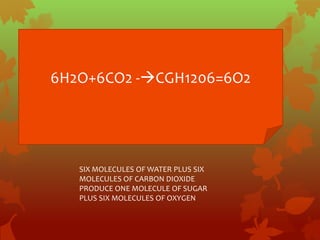Cent photosynthesis
- 2. -most of the time -the conversion of photosynthetic unusable sunlight process uses water and energy into usable release the oxygen chemical energy is that we absolutely associated w/ the must have to stay action of alive.(we need the chlorophyll (green food as well. pigment) -Process by w/c plants,some bacteria, some protistant used to produce sunlight.
- 3. 6H2O+6CO2 -’āĀCGH1206=6O2 SIX MOLECULES OF WATER PLUS SIX MOLECULES OF CARBON DIOXIDE PRODUCE ONE MOLECULE OF SUGAR PLUS SIX MOLECULES OF OXYGEN
- 4. LEAVES AND LEAF STRUCTURE -Leaf may be viewed as a solar collector cramned -plants are the only photosynthetic full of organism photosynthetic To have leaves .(not cells. all plants have leaves)
- 5. PRODUCT OF PHOTOSYNTHESIS SUGAR OXYGEN
- 6. CROSS SECTION OF LEAF ,SHOWING OF ANATOMICAL FEATURES IMPORTANT TO STUDY A PHOTOSYNTHESIS GUARD MESOPHYLL STOMATA VEIN CELL CELLS
- 7. XYLEM Water enters the root and itŌĆÖs transported up to leaves through specialized plant cell.
- 8. STOMATA Land plants must guard against drying out (dessication ) and so have evolved specialized structure known as stomata to allow gas to enter leaf and leave.
- 9. cuticle Waxy layer covering the leaf . CO2 canŌĆÖt pass for it
- 10. How to make SUGAR ( through process of PHOTOSYNTHESIS) Light, Co2,and H2O
- 11. The green pigment involved in photosynthesis it looks green because it absorb red and blue light













